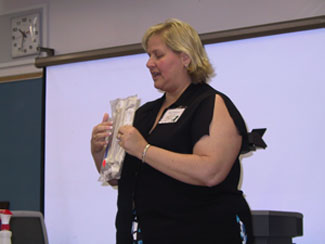Finding
More Donors
After weeks of planning, mailings and phone calls,
18-year-old senior Beverly Dedini sits on the floor of her Bear Creek
High School classroom and listens. As part of her senior project, Dedini
organized Organ and Tissue Awareness Day at her school, bringing together
donation advocates and recipients. Because of her efforts, students across
the sprawling Stockton, CA, campus are learning about how they can donate
their organs and tissue - and perhaps save someone's life.
Dedini understands how donation can change people's
lives because it changed her own. Dedini's father, Michael, 44, had suffered
since childhood from holes in his heart that eventually destroyed his
lungs. But eight years ago, he successfully received a heart and double
lung transplant that saved his life.
 |
|
photo Gina Comparini |
The awareness day that Dedini organized at Bear
Creek High is very much a hands-on event. In one room Mary Freeman, a
representative from the Northern California Transplant Bank, passes around
human bones in sealed packs. As the students press and examine the hard,
grayish bones, Freeman explains how parts of their bodies can be used
to help others. In a nearby room, a liver transplant
recipient tells another group of curious students how she was able to
attend college because a complete stranger died and gave her the gift
of life.
Organ and tissue donation is a chain with many
links. One person dies and gives an anatomical gift, another person receives
it, and the lives of family and friends on both sides change forever.
Community outreach and volunteerism are vital to the success of donor
organizations. Staff members at procurement organizations provide technical
information and other assistance, but volunteers bring the message and
mission to the public.
Some people volunteer for the outreach work because
they had made the decision to donate a loved one's organs or tissue after
they died. Others volunteer because they might have died had they not
received a donation. Then there are the many family members and friends
who volunteer because they would have lost a loved one if not for organ
donations.
Many people decide to become donors after hearing
volunteers speak, according to the California Transplant Donor Network.
"You really have to tap into your emotions,"
says Julie Moulet, one of the speakers at Dedini's awareness day event.
Moulet, who spoke with a framed photo of her daughter propped on one knee,
had donated her daughter's remains after she was killed in a car wreck
in 1992. Later that year, Moulet was diagnosed with liver failure. In
1997, she received a liver transplant from a 23-year-old man who died
in an accident.
 |
|
photo Gina Comparini |
Mary Freeman, a donor development coordinator with
the Northern California Transplant Bank, says that during her presentations
she tells students to go home and tell their parents what they learned
about donation.
"Their parents might say, 'Well, that's not
very nice,' or 'Don't even talk about that!' But at least it gets them
talking," she says.
Judging from the pained looks on some of the students'
faces, learning about brain death and organ and tissue donation isn't
easy. One student cried during a discussion because it reminded her of
a recent death in her own family. There were some silly questions about
brain transplants but also some thoughtful ideas about why more people
don't choose to donate. Bear Creek student opinion varied widely. In one
classroom, a young boy said he wanted his body buried, end of story. Others
said they felt donation was the only sensible thing to do.
Drawing on personal experiences keeps the audiences
listening, and, at times, laughing. Cathy Olmo from the California Transplant
Donor Network talks about how her daughter received a liver transplant
when she was only two years old.
"She was dying before my eyes," Olmo
says. "Now she is a teenager and she drives me crazy. I mean, I have
to dye my hair now."
Later, in another classroom, Olmo implores the
students not to keep quiet about what they want their final act on earth
to be. She holds up donor cards with pink donor dots supplied by the Department
of Motor Vehicles.
"You can make a decision, but you also need to share it with your friends and relatives," Olmo says, holding up a white donor card. "Spread the word!"
©2003 Gina Comparini
